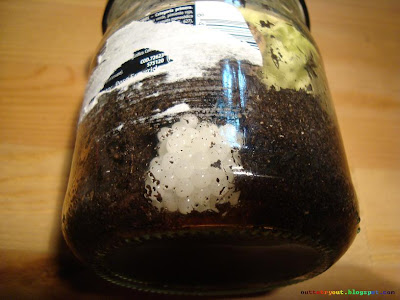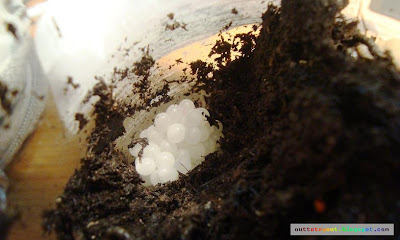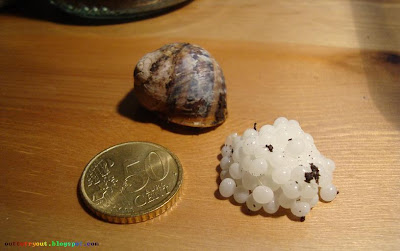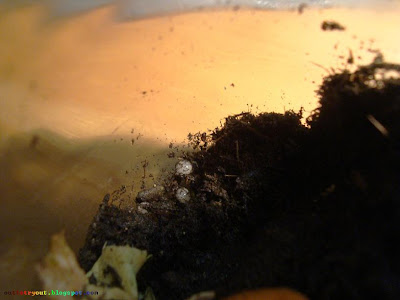Performing simple sicentific measurements (such as getting the heat capacity of a given material) having proper scientific equipment is an easy, probably boring task.
However, things get funnier when our means are limited. For example, what about calculating and comparing the heat capacity of organic tissue and inorganic matter using
only things you would find in
any kitchen, such as your grandmother's kitchen? This means you cannot use the infrared thermometer your phisicist friend use to have in the drawer. And yes, you are right, the average grandmother does not use a microwave. Not at least nowadays.
So, first of all, we have to set an hypothesis to prove or disprove (otherwise, no science can be done, and we would wander from one thing to another... which might be interesting as well, but would not be really scientific).
The idea: following a small poll among a few non-scientific friends, I have found out that most of them would use a 20 kg hot stone instead of 20 kg of equally hot ham to put under the bed in a cold night. In other words,
A piece of granite would absorb more heat than a piece of ham the same weight.so, according to this theory, if you had to store heat, you should use stones instead of food (provided that eating the food is cheating). Let us see if this is right.
The material: tap water, a freezer, a cooker, a small pot, three potatoes (sorry, no ham in my fridge, but these will do the trick), stones from the garden, a kitchen scale, a spoon (as stirring rod) and the timer of the cell phone (yes, I agree that the average grandmother would not have a cell phone, not at least in the kitchen, but you can always use your heartbeat... that is what Galileo did, and it worked pretty well for what he wanted to know about pendulums).
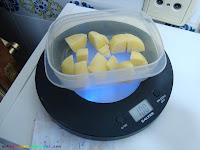
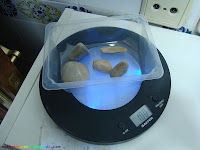
samples with 100 g of potatoes and 100 g of pabblesThe method: not having anything that resembles a thermometer, we will have to use as reference easy and a priori known temperatures. These could be the temperature of freezing water (0 ºC), the human body temperature (about 36 ºC) or the temperature of boiling water (100 ºC if you do not live too high; I live at 770 m, but this would just change this temperature
by about 3 ºC, a negligible error if we compare with the error from other measures). To reduce the huge error we are going to have, we will use the widest range available: from freezing water to boiling water.
So, we first need to have boiling water in the pot. Then,
we will drop in the 100 g of garden stones, which we have had for about five minutes in freezing water at 0 ºC, and calculate how long does it take for the water to boil again. Note that in order to make sure that the stones are at about 0 ºC, they must be in liquid water, but partially frozen; if we simply leave the stones in the freezer, they could easily reach temperatures of abuot -20 ºC.
We have to be as well careful when considering the boiling point: liquid water contains gases (air) dissolved in it, however, the amount of air dissolved is reduced with rising temperature (this is why salmons swim upriver, as cold water contains more oxygen for their offspring – you had one point in the chemistry exam if you knew this!), and this is the reason why a pot or a glass with hot water use to have little bubbles in its inner surface: they are the air that the water cannot keep any more.
But the appearance of these bubbles must not to be confused with the posterior boiling point.
Then, we
do the same for 100 g of raw potatoes and calculate the time the same way.
The heat capacity in J/kg·K will be:
(heat capacity in J/Kg•K) = (absorbed energy in J) / [(mass of pebbles/potatoes in kg) * 100 K]You will say
hey! how do I calculate the absorbed energy?. Well, that is why we are timing, as this can be calculated this way:
(energy absorbed by pebbles/potato in J) = (energy consumed by cooker in J) = (power of cooker in W) * (time in s)Yet another small problem: we have to calculate the power of our cooker. So, this is when we start the next step...
The measures: Calculation of the power of the cooker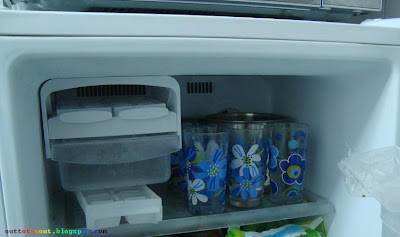
100 mL samples of water during cooling processProvided that the heat capacity of water is 4184 J/kg·K, I first used an indetermined amount of boiling water (to make sure the pot was already at about 100 ºC), dropped in 100 mL = 100 g of thawing/freezing (but not frozen) water, and calculated how long did it take for the water to boil again. I did this several times to have an average value:
| WATER | from time (s) | to time (s) | diff | s/kg |
| 100 g | 186.9 | 275.7 | 88.7 | 887 |
| 100 g | 275.7 | 354.7 | 79.1 | 791 |
| 100 g | 354.7 | 434.6 | 79.9 | 799 |
| 100 g | 434.6 | 517.1 | 82.5 | 825 |
| 100 g | 517.1 | 614.2 | 97.1 | 971 |
From these data we see that the average s/kg is 855 and the standard deviation is 75 s/kg. This way we can safely say that
the power of our cooker is (490 ± 40) W (taking into account the propagation of error).
Calculation of the heat capacity of the potatoes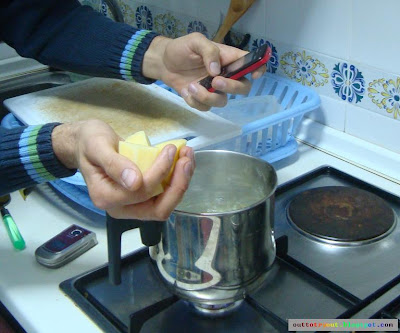
almost frozen potatoes about to be boiled, here the cell phone is used as stopwatch (the time the potatoes have been on the hand is negligible)Three samples were used: two of 100 g and a smaller one of 28 g. They were cut in small pieces to make sure that, when water was boiling around the potato,
the whole potato was at about 100 ºC. A spoon was used as stirring rod to guarantee the homogeneity of temperatures within the pot. This way, the following data were obtained:
| POTATO | from time (s) | to time (s) | diff | s/kg |
| 100 g | 0.0 | 91.0 | 91.0 | 910 |
| 100 g | 134.7 | 214.3 | 79.6 | 796 |
| 28 g | 222.9 | 247.7 | 24.8 | 885 |

as the almost frozen potatoes enter the pot, the water stops boiling until the cooker gives enough heat to restore the boiling pointThis gives us an average value for of 864 s/kg and a standard deviation of 60 s/kg, from which follows the
specific heat of potatoes: (4200 ± 600) J/kg•K.
Calculation of the heat capacity of stonesWe proceeded the same way, with the limitation that stones had not been broken into small parts.
| STONES | from time (s) | to time (s) | diff | s/kg |
| 100 g (several pebbles) | 319.6 | 362.3 | 42.7 | 427 |
| 137 g (conglomerate) | 384.0 | 459.1 | 75.1 | 548 |
More data could have been calculated, but as accuracy was not essential for this experiment, these were enough to get the average 488 s/kg and the standard deviation 86 s/kg, from which follows that the
heat capacity of the stones were (2400 ± 600) J/kg•K.
The results: the error in the experiment is high, which is a consequence of the poor equipment available and the fact that we just garnered a few data. However, it is enough to see that organic tissue has about twice as much heat capacity compared to inorganic material.
Conclusion: potatoes (and presumably most of organic "living" matter) has a heat capacity very similar to the water: compare (4200 ± 600) J/kg•K to the 4184 J/kg•K of water. This is not surprising as it is well known that water is the main component of living matter.
Let us compare the (2400 ± 600) J/kg•K we have calculated for stones to the heat capacites of other inorganic substances, such as
- iron: 450 J/kg•K
- graphite: 710 J/kg•K
- silicon: 703 J/kg•K
- beryllium: 1820 J/kg•K
- granito: 800 J/kg•K
- sodium chloride: 854 J/kg•K
- magnesium: 1020 J/kg•K
We can see that we have probably overestimated the heat capacity of our pebbles. Collecting more data and using bigger stones would provide more accurate information.
However, it is apparent the fact that for the same weight of pebbles and potatoes, the latter take quite longer to raise their temperature 100 ºC, which means they are storing more energy.
So,
now we can safely refute the original hypothesis:
it is indeed false that a piece of granite would absorb more heat than a piece of ham the same weight. Amusingly, and according to my fast poll, this seems to be counterintuitive.
I would be happy to read your comments about why should some people paradoxically think a stone is better than a piece of ham to keep oneself warm!


